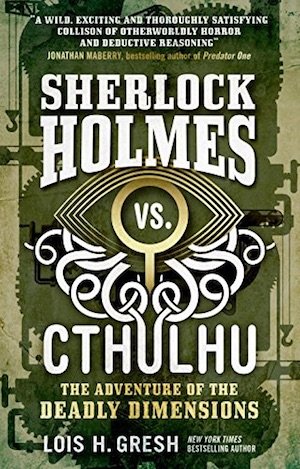
The year is 1890 and Holmes and Watson are thrown into a bizarre case by the visit of Willie Jacobs. The dishevelled Jacobs and his father have been running an experimental tram line in London’s East End. A bizarre machine powers the tram and father and son have been fuelling it with phosphorous. Now the father has died in mysterious circumstances, and Willie Jacobs is convinced the machine is the culprit. The strangeness of the claim and the ritualised component of the murder – the victim’s remains are little more than a jumble of bones on which sits a bizarre cube etched with runes – stimulate Holmes’ imagination, even if the supreme rationalist is dismissive of Jacobs’ opinion.
A failed attempt to shut the machine down leads to further tragedy, but Holmes remains convinced that a rational, scientific explanation can be found. His investigation leads to other similar murders in London and in the catacombs of Paris. Despite his commitment to the observable world, Holmes begins to question his beliefs after witnessing apparently supernatural creatures materialising out of thin air, when disguised as a cultist from The Esoteric Order of Dagon during a midnight ritual.
Gresh seems comfortable with the Lovecraftian angle to the mystery. The experienced Lovecraftian reader will recognise many tropes including non-Euclidean geometries, Deep Ones (foul man-fish hybrids), and their god Dagon. These elements are central to the story rather than just there to tick the Lovecraftian boxes, which sometimes happens with pastiches.
At the heart of weird fiction is a sense that the rules of nature have broken down, and it is often the writer’s aim to foster a sense of disorientation in readers that mirrors what the characters experience. You’ll begin a new chapter expecting to re-enter the story at a certain point only to discover Gresh has taken the narrative several steps forward, leaving you scrambling to catch up. If you’re more used to traditional, linear mysteries then you might find this a little frustrating at first, but my advice would be to persevere. Everything eventually becomes clear, and this trick adds to the menacing atmosphere Gresh is trying to create.
She depicts Holmes as a cold, aloof man, almost completely without social graces. The affectionate banter that is sometimes seen between the two friends is completely absent. Their friendship, at least from Watson’s perspective, is based on loyalty and a recognition that Holmes’ choice to involve him in the investigations has allowed Watson to rediscover a sense of purpose when he was at his lowest ebb. In fact, Watson’s inner struggle between his loyalty to Holmes and his duty as a husband to Mary and a father Samuel is one of the book’s strengths.
My only complaint is with the ending. The Deadly Dimensions is the first of a trilogy and though it is perfectly fine to leave something of a cliffhanger at the end of a series book, it is overdone here. Very little is really resolved and it feels more like the end of a particularly thrilling chapter than the end of a novel. That said, it is an engrossing 400-odd pages, and I will eagerly be returning for book two.
Our Halloween feature from 2013 examines some of the best supernatural thrillers, ranging from the early 20th century to the present day.
Titan Books
Print/Kindle
£3.79
CFL Rating: 4 Stars